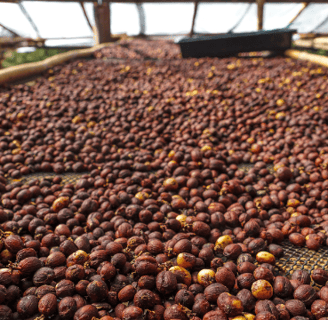Washed vs. Natural: Processing Differences Between Our Two Estates
Washed vs. Natural & More: How coffee processing shapes flavor at Jardin de Claude and Boun Thateng.
Ashok Srisenthuran
5/5/20255 min read


Washed vs. Natural: Processing Differences Between Our Two Estates
Hey coffee lovers! Once those beautiful, ripe coffee cherries have been carefully picked, they embark on perhaps the most transformative part of their journey – processing. This is where the magic really happens, and where our partner farms Jardin de Claude (Thailand) and Boun Thateng (Laos) showcase their unique approaches to turning cherry into bean.
Let's break down how these processing methods work, what makes each farm's approach special, and how all of this affects what ends up in your cup!
Coffee Processing 101: What's the Deal?
So, you've got these freshly picked coffee cherries – now what? Processing is essentially about removing all the fruity bits (pulp, mucilage, parchment) to get to the precious seed inside. But how you do this completely transforms the final flavor.
Think of it like cooking – same ingredients, different techniques, totally different results!
The Jardin de Claude Playbook: Processing Variety in Thailand
Our friends at Jardin de Claude in northern Thailand are total processing nerds (and we mean that in the best way possible). They've mastered a whopping FIVE different processing styles:
1. Washed Process
The "clean" method. They remove the cherry skin and pulp right away, then ferment the beans briefly to break down any remaining fruit mucilage before washing it all away. This process lets you really taste the bean itself – bright, clean flavors with pronounced acidity and clarity. It's like hearing each instrument in an orchestra clearly.
Their washed coffees have this amazing crisp citrus vibe with super clear flavor notes – think lemon zest, green apple, and jasmine.
2. Natural Process
The OG method! Whole cherries are dried in the sun, with the fruit surrounding the bean the entire time. As the cherry dries, it imparts fruity flavors and complexity to the bean.
Jardin de Claude's naturals are wild in the best way – expect bold blueberry, strawberry jam, and a syrupy body that coats your mouth. These coffees are like a fruit bomb in your cup!
3. Honey Process
Not actual honey, but the sticky mucilage is left on the bean during drying. The result? A sweet, complex cup that sits between washed and natural profiles.
Their honey process creates this beautiful balance of caramel sweetness and dried fruit notes – it's often our most popular offering because it hits this perfect middle ground.
4. Pink Process
This is where Jardin de Claude gets creative! It's a variation of honey processing where they leave a specific amount of mucilage on the bean, creating a pinkish color during drying. They're super precise about controlling the drying environment to create a unique profile.
These coffees are magical – gentle berry notes, pink grapefruit, and this amazing floral tea quality that's super distinctive.
5. 48-Hour Natural Fermented Process
The wild child of their lineup! They allow the whole cherries to ferment for exactly 48 hours before drying, which kicks off some fascinating microbial activity that creates totally unique flavor compounds.
Expect something funky and fascinating – tropical fruit notes, wine-like fermentation character, and a complex acidity that changes as the coffee cools. It's definitely a conversation starter!
Boun Thateng's Approach: Perfecting the Classics in Laos
Our Laotian partners at Boun Thateng focus on absolutely nailing three core processing methods:
1. Washed Process
Their washed coffees are all about showcasing the region's unique terroir. The Bolaven Plateau's volcanic soil comes through beautifully in their clean, articulate washed coffees.
These cups have this gorgeous chocolate backbone with bright stone fruit acidity and a super clean finish – perfect morning coffee that still feels special.
2. Natural Process
Boun Thateng has the perfect climate for natural processing – warm days and cool nights that allow for slow, even drying. Their drying patios are meticulously maintained, and the cherries are constantly raked to ensure even drying.
Their naturals are intensely sweet with distinct papaya, mango, and red berry notes. They've got this velvety mouthfeel that's just chef's kiss.
3. Honey Process
The team at Boun Thateng has perfected a medium honey process that results in exceptional complexity. They remove exactly the right amount of mucilage to balance fruity sweetness with clarity.
These coffees are like drinking liquid caramel with hints of stone fruit and baking spices – so comforting yet complex.
How Processing Shapes What's In Your Cup
Processing is basically like choosing a filter for your coffee flavor photo – it can completely transform the final result:
Washed coffees tend to be:
Brighter and more acidic
More transparent terroir expression
Cleaner mouthfeel
More pronounced floral notes
"Clarity" is the keyword here
Natural coffees typically deliver:
More body and sweetness
Stronger fruit-forward flavors
Wine-like complexity
Sometimes funky, fermented notes
"Bold" is the vibe
Honey processed coffees hit this sweet spot:
Balanced acidity and body
Enhanced sweetness
Subtle fruit notes with clarity
Smooth mouthfeel
"Balanced" is the perfect word
When we're cupping samples from both farms, it's fascinating to see how the same bean varietal processed differently can taste like completely different coffees!
The Environmental Angle: Processing and Sustainability
Processing isn't just about flavor – it has huge environmental implications:
Water Usage
Washed processing typically uses substantial water – around 1,000-2,000 liters per 100kg of coffee cherries! That's why both our partner estates have implemented water recycling systems.
Jardin de Claude has reduced their water usage by 40% over the past three years by implementing a sophisticated filtration system that allows them to reuse processing water multiple times.
Natural processing is inherently more water-efficient, using almost no water during processing. Boun Thateng leverages their abundant natural sunshine to make their natural processing super sustainable.
Waste Management
All those coffee cherry pulps have to go somewhere! Both farms have awesome composting programs:
Jardin de Claude uses their pulp waste to create organic fertilizer that goes right back into their fields, creating this beautiful closed-loop system.
Boun Thateng has taken it even further – they've started a community garden fertilized entirely by coffee processing byproducts. Local families now grow vegetables in soil enriched by coffee cherry compost!
Energy Considerations
Different processing methods require different energy inputs. Natural processing is typically more energy-efficient since it relies primarily on the sun, while washed processing can require equipment for pulping and washing.
Boun Thateng has installed solar panels to power their pulping machines, making their washed process more sustainable. Pretty cool, right?
Why Our Farms Choose Multiple Methods
So why not just pick one method and stick with it? Both farms believe in maximizing what their coffee can be. Different bean varieties respond better to different processing methods, and having multiple options allows them to highlight the best qualities of each harvest.
There's also the practical reality of climate – during particularly rainy periods, washed processing might be more reliable, while during dry seasons, natural processing becomes more viable.
Plus, let's be honest – variety is the spice of life! By offering multiple processing styles, our partner farms can create a diverse lineup of flavor experiences from the same trees.
Which Should You Try?
If you're new to specialty coffee, here's a quick guide:
Washed: If you love bright, clean coffees with pronounced acidity
Natural: If you're all about those fruit-forward, bold flavor bombs
Honey: If you want the best of both worlds – sweetness with clarity
Pink/48-Hour Fermented: When you're ready to get adventurous!
Personally, I love starting my day with a clean washed coffee from Boun Thateng, then switching to one of Jardin de Claude's funky naturals or that wild 48-hour fermented process in the afternoon when I'm ready for something more adventurous.
Next week, we'll dive into how these different processing methods affect brewing – because yes, that honey-processed coffee definitely wants to be brewed differently than its washed counterpart!
© 2024. One Estate. All rights reserved.


